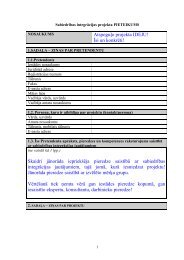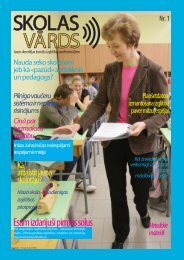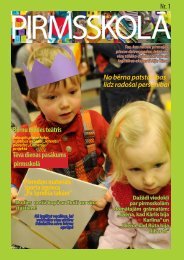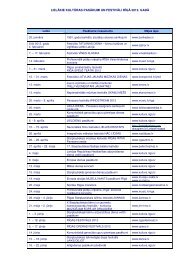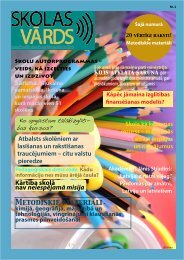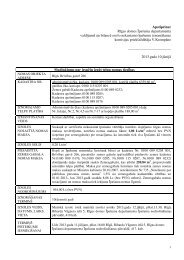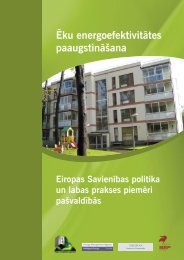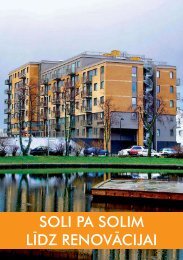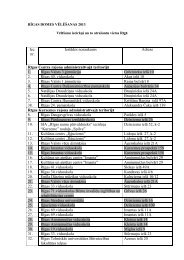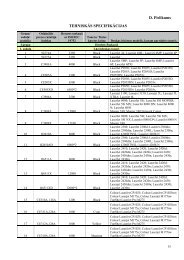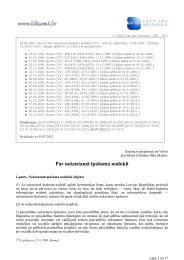Riga - European Capital of Culture 2014 candidate
Riga - European Capital of Culture 2014 candidate
Riga - European Capital of Culture 2014 candidate
- No tags were found...
You also want an ePaper? Increase the reach of your titles
YUMPU automatically turns print PDFs into web optimized ePapers that Google loves.
Latvians are in themselvesa kind <strong>of</strong> border. A borderbeyond which the unfamiliaror unknown begins.Important is the need for adequate infrastructure,cohesion <strong>of</strong> the social sphere and the city, creativeeconomy in the shape <strong>of</strong> support for different projects.In 6 years <strong>Riga</strong> will look different. Which <strong>of</strong> all <strong>of</strong> theabove-mentioned aspects will be topical still? Wemust focus on those who will remain topical.Depressedareas really arevery important.It would beimportant tothink about thistarget audience,it shouldn’t bethose who doattend eventsto a greater orlesser extent, but,if it is the city,then it should”encompass theentire city.<strong>Culture</strong> is aninterdisciplinaryphenomenon,which feeds <strong>of</strong>f theIt is importantto encouragethe miniaturecreativity ineach district,in each place<strong>of</strong> the city, tosearch for it,to find it andto support it.It isimportantnot justto build ahouse thatcreates theatmosphere<strong>of</strong> culture,but to dovery manyother thingsaround itas well,symbiosis <strong>of</strong> varioussectors. It is nota frozen dogma.Changeability and theability to react withprecision to whatis happening is one<strong>of</strong> its qualities. Thecultural environment<strong>of</strong> every city isdifferent, similarlyto food, which ismade up <strong>of</strong> differentingredients. <strong>Culture</strong>can have severalaxes in a city, severalcentres <strong>of</strong> gravity.Migration <strong>of</strong> the centre=suburb in the centre,centre in the suburb.The everyday as art=art as the everyday.to put thetransportand all theother thingsin order.border expansionThe idea <strong>of</strong> border expansion encompasses the expansion <strong>of</strong> theborders <strong>of</strong> both space and time, with the aim <strong>of</strong> making full use<strong>of</strong> the potential <strong>of</strong>fered by human resources and infrastructure.In Latvia’s case, <strong>Riga</strong> has amassed both cultural and spiritualpotential. The mobility <strong>of</strong> this creative potencial, and its promotionis envisaged in the “Mobile Centre” idea involving partners fromthe <strong>Riga</strong> region, other parts <strong>of</strong> Latvia and Europe.notion <strong>of</strong> spatial border expansion• The idea <strong>of</strong> spatial border expansion focuses on thecurrently dominant cultural forms being transferred to a differentgeographical space – outskirts, residential areas, out <strong>of</strong> the citycentre, stressing the idea <strong>of</strong> culture as a changeable centre <strong>of</strong>events. Currently, culture concentrates in the centre, while thesuburbs continue their life on the periphery. Through borderexpansion suburban cultural space is created anew, turningdepressed city regions into locations for creative and culturalevents.• The spatial aspect <strong>of</strong> border expansion also includes theexpansion <strong>of</strong> borders with the construction <strong>of</strong> new, significantcultural infrastructure facilities (the new Latvian National Librarywill connect Latvia’s regions into a common information networkand will develop intellectual and information cooperation networkswith other country databases; the new Contemporary Art Museumwill include <strong>Riga</strong> into the network <strong>of</strong> contemporary art processes,marking it as a new location for cultural dialogue on the map <strong>of</strong>contemporary world <strong>of</strong> culture).• Conscious <strong>of</strong> <strong>Riga</strong>’s dominance in Latvia’s spatial structuresand the growing intercity migration in Latvia, the borderexpansion concept also includes aspects <strong>of</strong> regional cooperation,development <strong>of</strong> cultural cooperation forms among towns andregions, thus decentralising cultural events and making use <strong>of</strong>infrastructure, encompassing as wide a cultural field as possibleand developing new forms <strong>of</strong> cooperation. The “Mobile Centre”idea, which is included in this concept, envisages the participation<strong>of</strong> <strong>Riga</strong> as the ECC in any location in Latvia, where it is possibleto create and make use <strong>of</strong> existing infrastructure, promote thecreation <strong>of</strong> new work and new forms <strong>of</strong> cooperation.• The spatial aspect <strong>of</strong> border expansion includesinterdisciplinary approach to changing the understanding <strong>of</strong> theconcept <strong>of</strong> culture, developing an open infrastructure, necessaryfor creative expression in various spheres <strong>of</strong> life, previouslyconsidered as not belonging to culture, and promoting thedevelopment <strong>of</strong> creative industries in <strong>Riga</strong> and Latvia.• The idea <strong>of</strong> border expansion sees <strong>Riga</strong> as a geographicaland cultural transit city, attracting creative people from otherplaces <strong>of</strong> the world, who would contribute to the development<strong>of</strong> a creative environment in <strong>Riga</strong>. <strong>Culture</strong> becomes not just aresource for participation, but also a significant instrument for thedevelopment <strong>of</strong> political, economic and diplomatic ties thanks to<strong>Riga</strong>’s geographic location and historic cultural ties – a bridgebetween East and West.border expansion time aspect• The concept <strong>of</strong> border expansion from the time aspectincludes predicting – what will be in six, ten years, who will be thepotential users <strong>of</strong> culture and participants <strong>of</strong> the creative processin <strong>2014</strong> and in the long-term, focusing attention on work withpotential target audiences already today.• Border expansion from the time aspect includes work with ageneration that is open to other, untraditional forms <strong>of</strong> the use <strong>of</strong>culture, leading us to research and predict, what forms <strong>of</strong> culturethe younger generations are using now, in their formative years,and what could be their development in the future.• Border expansion from the time aspect includes predictionin the context <strong>of</strong> demographic changes and economic globalisation.• Border expansion in a dimension <strong>of</strong> time confinement –accessibility <strong>of</strong> culture at different times <strong>of</strong> the day and night,which opens up a new dimension <strong>of</strong> perception and culturalexperience.* Focus group comments22 23



